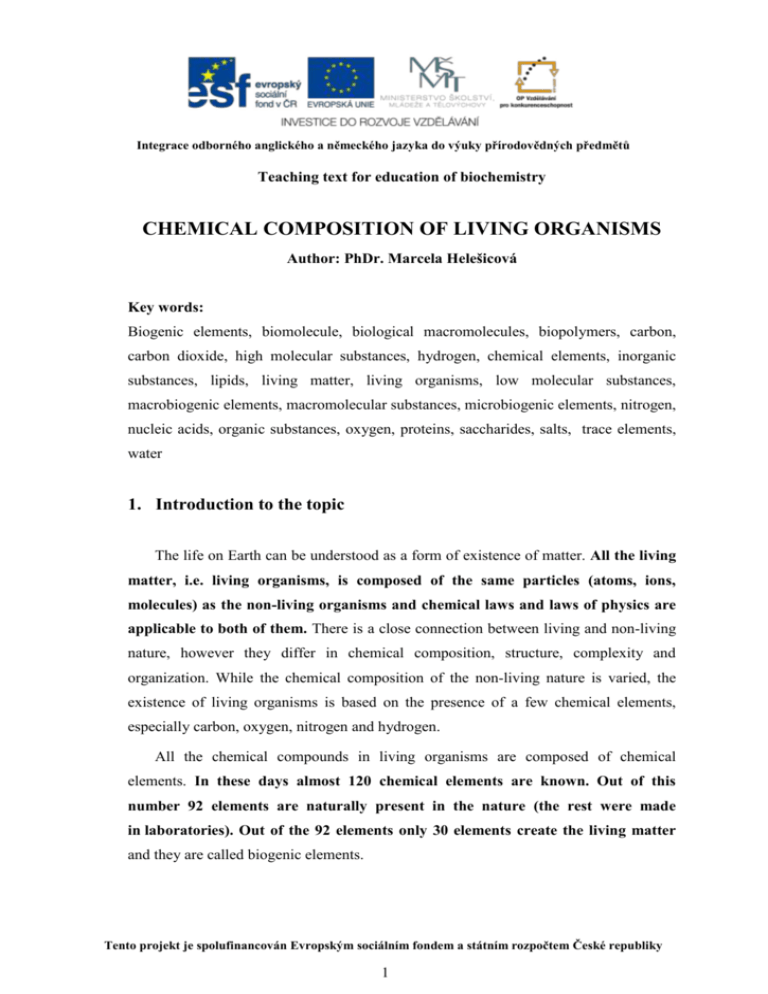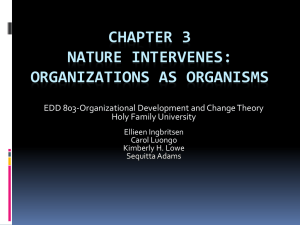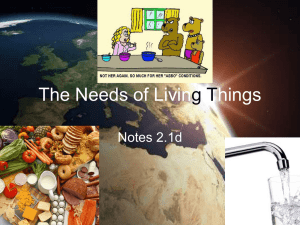2. Composition of elements in living systems
advertisement

Integrace odborného anglického a německého jazyka do výuky přírodovědných předmětů Teaching text for education of biochemistry CHEMICAL COMPOSITION OF LIVING ORGANISMS Author: PhDr. Marcela Helešicová Key words: Biogenic elements, biomolecule, biological macromolecules, biopolymers, carbon, carbon dioxide, high molecular substances, hydrogen, chemical elements, inorganic substances, lipids, living matter, living organisms, low molecular substances, macrobiogenic elements, macromolecular substances, microbiogenic elements, nitrogen, nucleic acids, organic substances, oxygen, proteins, saccharides, salts, trace elements, water 1. Introduction to the topic The life on Earth can be understood as a form of existence of matter. All the living matter, i.e. living organisms, is composed of the same particles (atoms, ions, molecules) as the non-living organisms and chemical laws and laws of physics are applicable to both of them. There is a close connection between living and non-living nature, however they differ in chemical composition, structure, complexity and organization. While the chemical composition of the non-living nature is varied, the existence of living organisms is based on the presence of a few chemical elements, especially carbon, oxygen, nitrogen and hydrogen. All the chemical compounds in living organisms are composed of chemical elements. In these days almost 120 chemical elements are known. Out of this number 92 elements are naturally present in the nature (the rest were made in laboratories). Out of the 92 elements only 30 elements create the living matter and they are called biogenic elements. Tento projekt je spolufinancován Evropským sociálním fondem a státním rozpočtem České republiky 1 Integrace odborného anglického a německého jazyka do výuky přírodovědných předmětů There are 92 elements in the Earth´s crust. Oxygen and silicon represent the highest percentage - 75% of all elements. Both these elements of the Earth´s crust, as well as the other elements, are bonded especially in minerals (e.g. oxides, silicates) and rocks. The remaining 90 elements represent about 25 % of all elements. Fig.: Representation of chemical elements in the Earth´s crust 2. Composition of elements in living systems In all living systems we can always find 4 basic elements: carbon, oxygen, nitrogen and hydrogen. Carbon is the basic building unit contained in living matter. The percentage of carbon in the mass of living matter is 19.4 %. Oxygen and hydrogen are present in almost all organic compounds which create living organisms. The percentage of oxygen in the mass of living systems is 62.8 %, the percentage of hydrogen is 9.3 %. The source of hydrogen for organisms is water, the source of oxygen is water and the atmosphere. Nitrogen is bonded mainly in amino acids, proteins and nucleic acids. Its percentage is 5.1 %. Tento projekt je spolufinancován Evropským sociálním fondem a státním rozpočtem České republiky 2 Integrace odborného anglického a německého jazyka do výuky přírodovědných předmětů Table: Comparison of basic biogenic elements representation in living and non-living matter Chemical element Average representation in Average representation in living matter (%) non-living matter (%) Carbon 19.37 % 0.18 % Oxygen 62.80 % 49.40 % Hydrogen 9.31 % 0.95 % Nitrogen 5.14 % 0.63 % 2.1 Biogenic elements All elements contained in living matter are called biogenic elements. They are present in compounds, in the form of ions and in some special cases they are unbound (e.g. oxygen). According to their representation in organisms, the biogenic elements are divided into 3 groups: macrobiogenic, microbiogenic and trace elements. Trace and microbiogenic elements are sometimes also called oligobiogenic elements. I. Macrobiogenic elements – C, O, H, N, S, P, Na, K, Ca, Mg, Cl, Fe. Four of these elements – O, C, H, N – represent up to 95 % of living matter. The rest of the elements mentioned above represent up to 4.9 %. Macrobiogenic elements have a building function. Carbon is the basis for all living matter. The typical feature of carbon atoms is the ability to bond to each other or to atoms of other elements. That is why there are many organic compounds of carbon. Carbon is also present in carbon dioxide and carbonates. Oxygen and hydrogen in organisms they are present both in the form of organic and inorganic compounds and they are a part of the basic micromolecule – water. Oxygen is produced by autotroph organisms (especially by plants and cyanobacteria) during the process of photosynthesis. Tento projekt je spolufinancován Evropským sociálním fondem a státním rozpočtem České republiky 3 Integrace odborného anglického a německého jazyka do výuky přírodovědných předmětů Nitrogen is a component of proteins and nucleic acids. It is also a part of nitrates and ammonium carbonate, which are necessary for the mineral nutrition of plants and also the synthesis of plant proteins. II. Microbiogenic elements – Cu, I, Mo, Mn, Zn, Co. The average content of these elements in living organisms is less than 0.1%. Microbiogenic elements have catalytic function, i.e. they are part of enzymes. III. Trace elements – e.g. Al, As, B, Br, F, Li, Ni, Se, Si, Ti, V. Their content in organisms is less than 0.001 %. As well as microbiogenic elements, trace elements are parts of enzymes and their function is catalytic. 3. Chemical composition of living systems Living organisms are composed of several types of substances called biomolecules. According to their molecular weight, substances in living organisms are divided into two groups: 1. Low molecular substances (Mr < 10 000) • water • inorganic (mineral) substances • intermediates of metabolic pathways (carboxylic acids etc.) • final products of metabolic pathways (amino acids, monosaccharides, lipids, nucleotides) 2. High molecular substances (Mr > 10 000) • proteins • polysaccharides • nucleic acids Tento projekt je spolufinancován Evropským sociálním fondem a státním rozpočtem České republiky 4 Integrace odborného anglického a německého jazyka do výuky přírodovědných předmětů High molecular substances, which are present in living organisms, are also named as biological macromolecules or biopolymers. The building units of proteins are amino acids, the building units of polysaccharides are monosaccharides, and the building units of nucleic acids are nucleotides. According to their origin, the substances included in the living organisms are divided into inorganic substances (water, carbon dioxide, mineral substances) and organic substances (the most important are nucleic acids, proteins, saccharides, lipids). Fig.: Average representation of the main groups of substances in organisms 3.1. Water and mineral substances The most frequent and the simplest biomolecule in living systems is water. Water is basic and the most spread inorganic compound contained in living organisms. The average content of water in organisms is 60-70 %. The amount of water depends on the surroundings in which the organism lives, on a kind of organism, on its age. The amount of water also depends on specific parts of body, e.g.the highest percentage of water in human body is in body fluids and the lowest in fatty, dental or bone tissue. Tento projekt je spolufinancován Evropským sociálním fondem a státním rozpočtem České republiky 5 Integrace odborného anglického a německého jazyka do výuky přírodovědných předmětů Water in organisms helps to create their inner environment and keep their stability. Water is a dissolving agent, transporting medium and a thermoregulator. Bochemical reactions in living systems happen in water environment. Inorganic salts can be either water-soluble, i.e. dissociated into ions, or insoluble. Insoluble salts are present in hard connective tissue such as teeth, bones or shells. Examples: Ca3(PO4)2 (bones, teeth), CaCO3 (bones, shells of invertebrates), CaF2 (teeth). Soluble salts in the form of ions are mainly in body fluids. The main extracellular ions are cation Na+ and anion Cl-. The main intracellular ions are cation K+ and cation Mg2+ . Very important compound is carbon dioxide, which is necessary for photosynthesis. It is produced in metabolic (catabolic) processes, e.g. when breathing. 3.2. Organic matters The most important organic matters necessary for organism structure and function are: proteins nucleic acids saccharides lipids Organic matters represent more than 30% of organism mass. The rest is represented by water and mineral matters. The individual groups of organic substances will be presented later. Tento projekt je spolufinancován Evropským sociálním fondem a státním rozpočtem České republiky 6 Integrace odborného anglického a německého jazyka do výuky přírodovědných předmětů 4. Questions and tasks – Chemical compositions of living organisms 1) Which two chemical elements are the most frequent in the Earth’s crust and what is their form? 2) What are biogenic elements, how do we divide them? 3) Name 4 basic macroelements. Why are they important? What is their content (percentage) in living organisms? 4) Name the microbiogenic elements and give examples of their importance. 5) What is the function which is common for trace elements and what is their content in living organisms? 6) Explain the term biomolecule. Which element forms biomolecules? 7) What is the average content of water in organisms and what is its function? 8) Give 3 examples of non-dissociated salts which are present in human body. Give examples of tissues, where the salts are present. 9) Name the basic groups of biopolymers and name the building units they consist of. 10) Give the average percentage of proteins, saccharides, lipids and nucleic acids in living organisms. Tento projekt je spolufinancován Evropským sociálním fondem a státním rozpočtem České republiky 7










